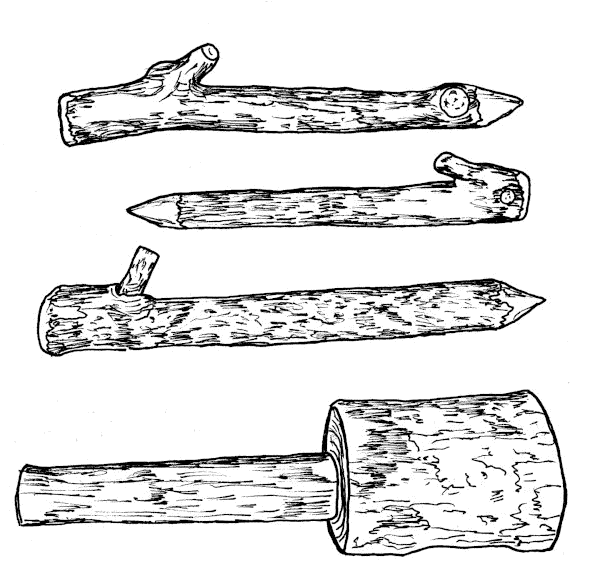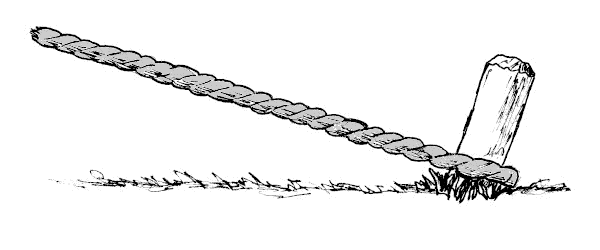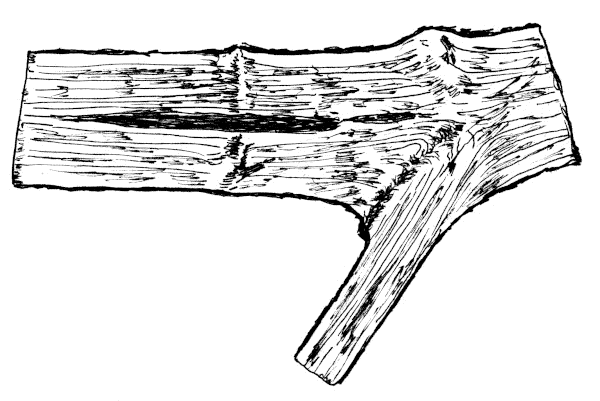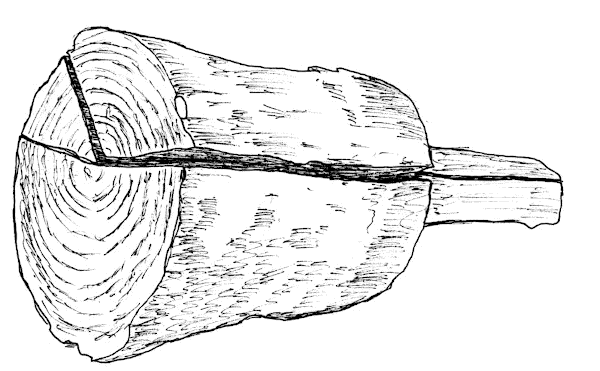
Figure 1: Three Tent Stakes and a Maul.
| Home | Equipment | Ropemaking |

Figure 1: Three Tent Stakes and a Maul.
If you have a tent, or a canopy, then you'll need tent stakes. You don't need anything fancy. Just a fairly straight piece of wood with a pointy end.[295] [035] If you drive it at an angle to the ground, in the direction away from the pull on your rope, then the rope generally won't pull off. Keep your loop as close to the ground as possible. That keeps the rope from leveraging the stake out.

Figure 2: Rope Around a Properly Angled Stake.
At market fairs, the sutlers and blacksmiths will gladly sell you iron stakes. These are very strong. And pretty heavy. They were also expensive. Until the Revolution, most iron work, even including nails, was imported from England.[ 479]
There are patterns for turned wood stakes, but you need a lathe to make those. Other stakes have carved notches to keep the rope from slipping. But unless you are very careful with the wood grain, you're just adding a weakness to the stake. A wrong blow with the mallet, or a sharp twist of the rope, will split the spur right off.

Figure 3: Wood Grain at a Branching Fork.
Finding a straight branch, 16 inches long, between one and two inches in diameter, with a good sized side branch, is harder than it first sounds. Remember, if it didn't grow straight, it won't drive straight.
Trees don't often cooperate. But if you spend enough time in the woods with your eyes open, eventually you will find enough branches to make all the stakes you need for your camp. And you will have spent time in the woods, paying attention to the trees. That's not a bad way to spend your time.
But the other end of the stake also needs attention.[295] [815] The head should be rounded so it doesn't mushroom and split when you drive it into the ground.
Note: My Osage Orange maul split in January 2022, while riving some well-seasoned red oak.

Figure 4: Split Osage Orange Maul.
Even with a split running from the head, all the way down through the handle, I was able to finish the work I was doing, and the maul held together.
This maul worked well for over five years. Rather than consign it to the fire place, I'm going to make lucets from the head.

Figure 5: A Staked Out Tent Stake.
Loop the middle of a sling around the top of your tent stake with a clove hitch (ABOK[040] #11) or constrictor knot (ABOK[040] #1249), then stake out each end with another stake.
035
Army, Department of the (October 1968)
TM 5-725 Rigging.
Accessed 21 July 2021 from
http://www.jatonkam35s.com/DeuceTechnicalManuals/Tm5-725-Rigging.pdf
295
Graves, Richard (1978)
Bushcraft.
Accessed 27 July 2021 from
https://chrismolloy.com/p134.php
Rogers, Harry (2017)
How To Make Traditional Wooden Tent Pegs.
Accessed 27 July 2021 from
https://www.youtube.com/watch?app=desktop&v=RGrvqM73yvc
815
Underhill, Roy (1981)
The Woodwright's Shop
Hardcopy
University of North Carolina Press
ISBN 0-8078-1484-9
| Colophon | Contacts |